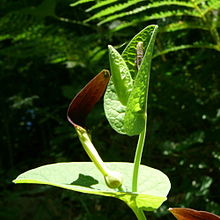- Smearwort
-
Smearwort 
Scientific classification Kingdom: Plantae (unranked): Angiosperms (unranked): Magnoliids Order: Piperales Family: Aristolochiaceae Genus: Aristolochia Species: A. rotunda Binomial name Aristolochia rotunda Smearwort (Aristolochia rotunda), also known as Round-leaved Birthwort, English Mercury, Mercury Goosefoot, Allgood, Tola Bona or (ambiguously) "Fat Hen", is a herbaceous perennial plant native to Southern Europe.
Contents
Etymology
The genus name aristolochia derives from the Greek words αριστος (aristos) meaning "the best" and 'lochéia' meaning ' childbirth', for the old use in promoting uterine contractions. The Latin name of the species rotunda refers to the rounded shape of the leaves.
Botanical description
Smearwort is a dark-green succulent plant that grows to about 60–70 centimetres (24–28 in) high, rising from stout, fleshy, branching root-stock. The root reaches 5–25 centimetres (2.0–9.8 in) in length and sometimes seems out of proportion to the slenderness of the plant. The unbranched stem has alternate, large, smooth-edged, heart-shaped and stalkless leaves that clasp the stem with enlarged, basal lobes. The solitary flowers have an unpleasant odor and they are tubular, about 2.5–5 centimetres (0.98–2.0 in) long, yellowish-green with a prominent, dark-brown or dark purple flap, both arising from the axils of the leaves. The fruit is bladder-like of about 2 centimetres (0.79 in) in diameter and contains a single seed. The flowering period extends from April through June.
Reproduction
The flowers of Aristolochia rotunda are hermaphrodite are pollinated by midges and other small insects (entomophily), attracted by the smell and by purple-brown color of the flowers. The small hairs inside the cup prevent the flies to come out and fly away. After the pollination these hairs sag and allow them to escape.
This species is the only host plant of the caterpillars of a beautiful uncommon butterfly (Zerynthia polyxena). Eating the leaves of the plant the larvae this insect ingest aristolochic acid that make them poisonous to birds.
Distribution
This plant is common in Mediterranean countries. It is rarely naturalized in the British Isles.
Habitat
These plants occur along the banks of canals, edges of ditches and fields, sides of roads, meadows, slopes and forests. They prefer chalky soils and moist, shady areas, at an altitude of 0–800 metres (0–2,600 ft) above sea level.
Uses
The name Smearwort is derived from its use as ointment. Poultices derived from the leaves were used to heal chronic sores. Roots were often used on sheep to remedy cough. And, the seeds have found employment in the making of shagreen. Smearwort leaves can be gathered when young and delicate, then boiled in broth. If grown in rich soil, the shoots may be cut when no bigger than a pencil and five inches high, to be peeled and boiled, then eaten as asparagus.
Subspecies
- Aristolochia rotunda subsp. rotunda, autonym
- Aristolochia rotunda subsp. insularis (E.Nardi & Arrigoni) Gamisans
- Aristolochia rotunda subsp. reichsteinii E.Nardi
Gallery
References
- Medicinal herbs
- Tela Botanica / 2000-2009 - Le réseau des Botanistes Francophones [1].
- Pignatti S. - Flora d'Italia - Edagricole – 1982, Vol. I, pag 135
- Tutin, T.G. et al. - Flora Europaea, second edition - 1993
- Björn Rulika, Stefan Wankeb, Matthias Nussa and Christoph Neinhuisb Pollination of Aristolochia pallida Willd. (Aristolochiaceae) in the Mediterranean - Flora - Morphology, Distribution, Functional Ecology of Plants - Volume 203, Pages 175-184
- Wikispecies
- Wikimedia Commons
External links
Categories:- Aristolochia
- Medicinal plants
- Plant common names
Wikimedia Foundation. 2010.






